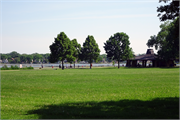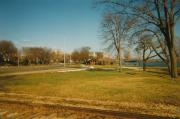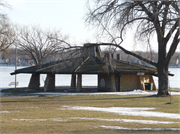Property Record
801 W WASHINGTON AVE
Architecture and History Inventory
| Historic Name: | Brittingham Park |
|---|---|
| Other Name: | Brittingham Park |
| Contributing: | |
| Reference Number: | 122079 |
| Location (Address): | 801 W WASHINGTON AVE |
|---|---|
| County: | Dane |
| City: | Madison |
| Township/Village: | |
| Unincorporated Community: | |
| Town: | |
| Range: | |
| Direction: | |
| Section: | |
| Quarter Section: | |
| Quarter/Quarter Section: |
| Year Built: | 1903 |
|---|---|
| Additions: | |
| Survey Date: | 20012019 |
| Historic Use: | park |
| Architectural Style: | Prairie School |
| Structural System: | |
| Wall Material: | |
| Architect: | O.c. Simonds |
| Other Buildings On Site: | |
| Demolished?: | No |
| Demolished Date: |
| National/State Register Listing Name: | Not listed |
|---|---|
| National Register Listing Date: | |
| State Register Listing Date: |
| Additional Information: | City of Madison, Wisconsin Underrepresented Communities Historic Resource Survey Report: Rodney Scheel started the annual Back Door Picnic at Brittingham Park in 1972, as a modest event to thank his The Back-Door bar patrons. The event was usually held on the third weekend of July and provided a casual summer scene for making contact and building community. The picnic evolved into an important public gathering of LGBTQ people and friends. In 1977 or 1978, a nationwide campaign against municipal gay civil rights laws reached into Madison in an attempt to repeal the city’s 1975 Non-Discrimination Ordinance, which offered protections for LGBTQ people. The campaign, led nationally by singer Anita Bryant and locally by an evangelical minister, failed, but two consequential groups formed in response to the effort: The United, a political advocacy group, and the Madison Area Gay Interim Committee (MAGIC), a coalition of gay bars. In 1978, MAGIC assumed stewardship of the annual Back Door Picnic and renamed it the MAGIC Picnic. One of the most important goals of the Gay Liberation Movement in Madison was to increase the visibility of LGBTQ people. Visibility, it was argued, would help counteract negative portrayals and perceptions of queer people. Coming out would help break down stereotypes, challenge prejudice and discrimination, and normalize queerness. At a time when the AIDS crisis was forcing visibility on the LGBTQ community by striking gay men disproportionately, positive visibility meant increased empathy for and attention to the crisis from the public, government agencies, and medical profession. Madison’s LGBTQ community increased its visibility dramatically in the 1970s through the late 1980s, and the MAGIC Picnic at Brittingham Park was one way they did so. The MAGIC Picnic was a major public LGBTQ social event. It charged an entrance fee and offered drinks, food, games, a volleyball tournament, swimming, dancing, DJs and live music, and the annual Drag Race in which participants would don traditionally female shoes, wigs, and clothing as they ran the course. As the MAGIC Picnic continued to grow, it attracted people from around the Midwest. In 1982 the event attracted around 800 people, and, by 1983, it was being advertised throughout Wisconsin and in Chicago and Minneapolis. Coordinators would shift the regular late-July date to avoid conflicting with Pride events in Chicago and Milwaukee. In its heyday in the mid-1990s, the MAGIC Picnic attracted thousands of participants from around Wisconsin and the Midwest. By the late 1980s, the picnic had become Madison’s default LGBTQ Pride event. Through the 1990s, the MAGIC Picnic competed with the official Madison Lesbian and Gay Rights and Pride march/parade event that began in 1989, but the MAGIC event was “a far bigger gathering of gays, lesbians, and friends.” From 1972 to 2002, the MAGIC Picnic was a public event at Brittingham Park where queer people found a supportive and welcoming community. The MAGIC Picnic and Madison Pride joined forces from 2002 until 2008 to combine their events under the moniker of MAGIC Weekend. In 2009, it was reorganized as the Wisconsin Capital Pride and moved from Brittingham Park. In 2014, the annual event was taken over by OutReach, Inc., renamed the OutReach Pride Parade and Rally, and moved to State Street and Capitol Square. To celebrate the fiftieth anniversary of the Stonewall riots, the 2019 event has been named the OutReach MAGIC Festival. "The role of the Madison Park and Pleasure Drive Association in creating modern Madison is not as well known today as it was in 1939 when Ladislas Segoe, the nationally famous urban planner stated that: "What started out as a movement by a small group of men to create pleasure drives through some of the beautiful scenery along the lakes assumed wider portions until it has become a real force in shaping the development of the city." The Association;s principal tools were the parks that is was instrumental in developing in the first decade of the [20th] century along Madison's then underutilized lake shores. The largest of these parks (Tenney Park, Vilas Park, and Brittingham Park) were each constructed by filling in low-lying marsh land with materials dredged up from the adjacent lakes. Since these parks were then located either on the outskirts of the city of in area rendered unusable by swampy conditions, the timely transformation of the area gave the largely underdeveloped suburbs that surrounded them a major boost and helped steer development activity in their direction. In 1905, prominent Madison lumberman and civic benefactor Thomas Brittingham (1860-1924) pledged the sum of $8,000 for the creation of a park along the shore of the "stinking slough" known today as Monona Bay. This area was then mostly a swampy dumping ground. Over the next six years, however, the work of the Association and Brittingham's continuing largess transformed this area into an urban showpiece. Its new bathhouse and beach became a a favorite summer pleasure ground for all of Madison, but especially for the nearby Italian-American community in the Greenbush Addition, who fondly referred to it as "Columbus Park" in honor of their illustrious countryman. Ultimately Brittingham's gifts totalled $24,500 for which the city gained a 27-acre park that eventually extended around almost the entire shoreline of Monona Bay, plus a bathhouse (demolished), and a boathouse that is now a Madison Landmark." The Greenbush-Vilas Neighborhood: A Walking Tour. Madison Landmarks Commission and the Brittingham-Vilas Neighborhood Association, 1991. |
|---|---|
| Bibliographic References: | Architecture/History Survey 2001: Elizabeth Miller. The Greenbush-Vilas Neighborhood: A Walking Tour. Madison Landmarks Commission and the Brittingham-Vilas Neighborhood Association, 1991. |
| Wisconsin Architecture and History Inventory, State Historic Preservation Office, Wisconsin Historical Society, Madison, Wisconsin |



